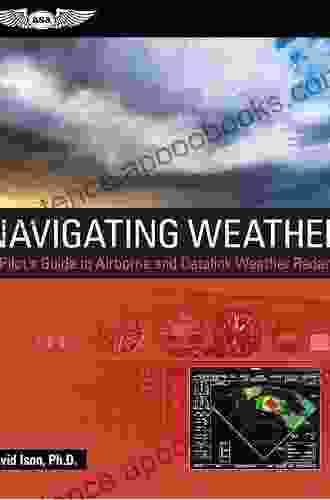Pilot Guide to Airborne and Datalink Weather Radar: Unlocking the Secrets of the Skies

In the realm of aviation, weather radar stands as an indispensable tool, providing pilots with a crucial advantage in navigating the treacherous skies. Airborne and datalink weather radar systems have revolutionized the way pilots interpret and anticipate weather patterns, enabling them to make informed decisions that ensure flight safety and passenger comfort. This comprehensive guide delves into the intricacies of these vital systems, empowering pilots with a deep understanding of their capabilities and effective utilization.
Chapter 1: Airborne Weather Radar: A Pilot's Eye View
Airborne weather radar is a self-contained system installed on an aircraft. It emits pulses of electromagnetic energy and analyzes the returning energy to create a graphical representation of precipitation and other weather phenomena within the radar's range. Pilots can customize the display to highlight specific parameters, such as reflectivity, turbulence, and vertical cross-sections.
4.2 out of 5
| Language | : | English |
| File size | : | 22805 KB |
| Text-to-Speech | : | Enabled |
| Screen Reader | : | Supported |
| Enhanced typesetting | : | Enabled |
| Print length | : | 299 pages |
| Lending | : | Enabled |
| Item Weight | : | 1.01 pounds |
| Dimensions | : | 5.55 x 0.79 x 8.5 inches |
Key Features:
* Real-time updates of weather conditions * Narrow beamwidth for accurate detection * Customizable display options for enhanced visualization
Advantages:
* Provides unparalleled situational awareness * Enables early identification of hazardous weather * Supports tactical decision-making, such as route adjustments and altitude changes
Chapter 2: Datalink Weather Radar: Extending the Reach
Datalink weather radar offers pilots access to weather data beyond the range of airborne radar systems. It transmits radar images and other meteorological information via satellite or cellular networks, allowing pilots to receive up-to-date weather information while in flight.
Key Features:
* Coverage extends beyond the aircraft's range * Provides detailed information on larger-scale weather patterns * Enables route planning and optimization based on comprehensive weather data
Advantages:
* Enhances situational awareness over long distances * Supports strategic flight planning * Reduces the risk of encountering unexpected weather conditions
Chapter 3: Interpreting Weather Radar Imagery: A Pilot's Guide
The key to utilizing weather radar effectively lies in interpreting the imagery correctly. Different colors and patterns on the radar display represent various types of precipitation and weather conditions. Pilots must develop a thorough understanding of these symbols and their implications for flight safety.
Reflectivity: Measures the intensity of precipitation and is represented by colors ranging from green (light) to red (heavy).Velocity: Indicates the direction and speed of precipitation, providing valuable information about wind direction and turbulence.Horizontal Cross-Sections: Displays a vertical slice of the atmosphere, revealing the height and structure of storms and precipitation layers.
Chapter 4: Airborne Weather Radar Techniques for Improved Situational Awareness
Pilots can employ a range of techniques to maximize the benefits of airborne weather radar. These techniques include:
* Tilt Control: Adjusting the tilt angle of the radar beam optimizes detection at different altitudes and distances. * Gain Control: Regulating the sensitivity of the radar receiver enhances the visibility of weak or distant echoes. * Clutter Filtering: Discriminating between ground clutter and precipitation targets improves the accuracy of radar imagery.
Chapter 5: Datalink Weather Radar Strategies for Flight Planning
Datalink weather radar offers valuable insights for flight planning and optimization. Pilots can leverage this data to:
* Identify Potential Hazards: Examine weather patterns over a wide area to identify regions of severe weather, turbulence, and icing. * Plan Alternative Routes: Determine alternative flight routes based on the predicted movement of weather systems. * Estimate Flight Time: Utilize radar imagery to assess the impact of weather on flight duration and fuel consumption.
Chapter 6: Advanced Radar Technologies for Enhanced Flight Safety
Ongoing advancements in weather radar technology are pushing the boundaries of situational awareness and flight safety. These technologies include:
* Dual-Polarization Radar: Transmits both horizontal and vertical polarization signals to differentiate between liquid and frozen precipitation. * Doppler Velocity Enhancement: Detects and measures very low airspeeds, providing early warning of wind shear and turbulence. * Lightning Detection: Integrates lightning data into radar imagery, enabling pilots to anticipate electrical activity and avoid dangerous storms.
The Pilot Guide to Airborne and Datalink Weather Radar empowers pilots with the knowledge and skills to harness the power of these essential systems. By understanding the principles of operation, interpreting radar imagery accurately, and employing advanced techniques, pilots can optimize flight safety, passenger comfort, and flight efficiency. As weather patterns become increasingly complex and unpredictable, mastering the art of weather radar interpretation has never been more critical. Embrace the knowledge contained within this guide and soar above the challenges of the skies with confidence and precision.
4.2 out of 5
| Language | : | English |
| File size | : | 22805 KB |
| Text-to-Speech | : | Enabled |
| Screen Reader | : | Supported |
| Enhanced typesetting | : | Enabled |
| Print length | : | 299 pages |
| Lending | : | Enabled |
| Item Weight | : | 1.01 pounds |
| Dimensions | : | 5.55 x 0.79 x 8.5 inches |
Do you want to contribute by writing guest posts on this blog?
Please contact us and send us a resume of previous articles that you have written.
 Book
Book Novel
Novel Page
Page Chapter
Chapter Text
Text Story
Story Genre
Genre Reader
Reader Library
Library Paperback
Paperback E-book
E-book Magazine
Magazine Newspaper
Newspaper Paragraph
Paragraph Sentence
Sentence Bookmark
Bookmark Shelf
Shelf Glossary
Glossary Bibliography
Bibliography Foreword
Foreword Preface
Preface Synopsis
Synopsis Annotation
Annotation Footnote
Footnote Manuscript
Manuscript Scroll
Scroll Codex
Codex Tome
Tome Bestseller
Bestseller Classics
Classics Library card
Library card Narrative
Narrative Biography
Biography Autobiography
Autobiography Memoir
Memoir Reference
Reference Encyclopedia
Encyclopedia Dr Janet Awokoya
Dr Janet Awokoya Ryan D Griffiths
Ryan D Griffiths Henry Dunant
Henry Dunant Eliza Ester
Eliza Ester Keith Hosman
Keith Hosman Elinor De Wire
Elinor De Wire Dill Pickles
Dill Pickles Dalton Smith
Dalton Smith Lionel Shriver
Lionel Shriver Hilary Stokes Phd
Hilary Stokes Phd Carlin Borsheim Black
Carlin Borsheim Black Andrew Grant
Andrew Grant Emily Mackay
Emily Mackay Elizabeth Todd Breland
Elizabeth Todd Breland Jessie Kelley
Jessie Kelley Emilio Salgari
Emilio Salgari Benedict Freedman
Benedict Freedman Judith M Dunkerly
Judith M Dunkerly Sean Stevens
Sean Stevens Thomas J Parente
Thomas J Parente
Light bulbAdvertise smarter! Our strategic ad space ensures maximum exposure. Reserve your spot today!

 Hank MitchellBoomer Railroad Memoirs: A Captivating Journey Through the Past and Present...
Hank MitchellBoomer Railroad Memoirs: A Captivating Journey Through the Past and Present...
 Jonathan HayesPsychoanalysts' Reflections on Finality, Transformations, and New Beginnings
Jonathan HayesPsychoanalysts' Reflections on Finality, Transformations, and New Beginnings John GrishamFollow ·18.2k
John GrishamFollow ·18.2k Aubrey BlairFollow ·12k
Aubrey BlairFollow ·12k Rubén DaríoFollow ·5.7k
Rubén DaríoFollow ·5.7k Samuel Taylor ColeridgeFollow ·12.8k
Samuel Taylor ColeridgeFollow ·12.8k Art MitchellFollow ·6.2k
Art MitchellFollow ·6.2k Mike HayesFollow ·12.3k
Mike HayesFollow ·12.3k Oscar BellFollow ·18.2k
Oscar BellFollow ·18.2k Phil FosterFollow ·14.2k
Phil FosterFollow ·14.2k

 Julian Powell
Julian PowellShetland Pony: Comprehensive Coverage of All Aspects of...
The Shetland...

 Cason Cox
Cason CoxHow Anaesthetics Changed the World: A Medical Revolution...
Imagine a world where surgery is an...

 Harold Powell
Harold PowellUnleash Your Inner Songwriter: The Ultimate Guide for...
Calling all aspiring songwriters!...

 Nikolai Gogol
Nikolai GogolUnleash Your Artistic Potential: Quick Draw Anatomy for...
In the dynamic and visually...

 Tim Reed
Tim ReedThe Rock 'n' Roll Life of Legendary Sax Man Bobby Keys
The Rock 'n' Roll Life...

 Damon Hayes
Damon HayesMoney Management Activities for Youth: A Guide to...
In an era marked by rapidly...
4.2 out of 5
| Language | : | English |
| File size | : | 22805 KB |
| Text-to-Speech | : | Enabled |
| Screen Reader | : | Supported |
| Enhanced typesetting | : | Enabled |
| Print length | : | 299 pages |
| Lending | : | Enabled |
| Item Weight | : | 1.01 pounds |
| Dimensions | : | 5.55 x 0.79 x 8.5 inches |








